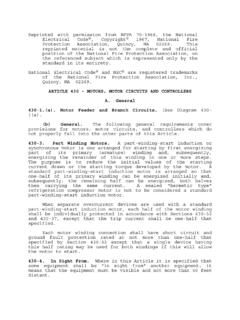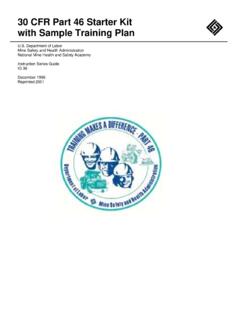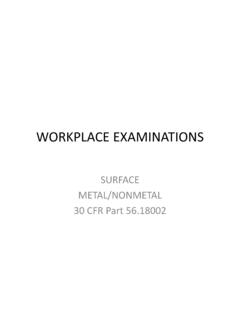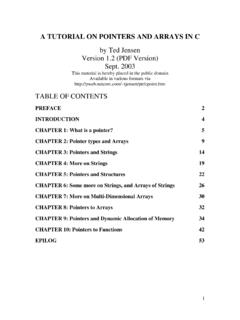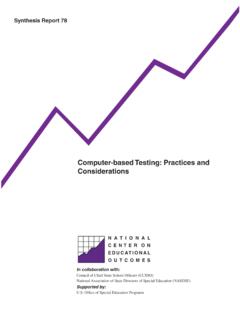Transcription of BACKHOE AND HYDRAULIC EXCAVATOR OPERATION
1 MODULE NUMBER 5 OFINSTRUCTION GUIDE NUMBER 43ON-THE-JOB TRAINING MODULESFORSURFACE METAL AND NONMETAL MINESBACKHOE AND HYDRAULIC EXCAVATOR OPERATIONThis module describes the basic job steps, potential hazards or accidents, andrecommended safe job procedures for BACKHOE and HYDRAULIC EXCAVATOR are used at surface metal and nonmetal mines for various types of versatiity makes these machines widely used pieces of mobile were designed basically for ditching and cleanup. Their use has beenbroadened to include removal and loading of ore and overburden material by largebackhoes, known as HYDRAULIC operators must be aware of some of the same general types of hazards as othermobile equipment operators.
2 Many job procedures and related hazards are common tothe OPERATION of all mobile most common hazards related to BACKHOE and EXCAVATOR OPERATION are: slipping andfallng of the machine operator, tipping or overturning of the machine, and contactingenergized power lines with the and falls occur most often when mounting and dismounting, cleaning windows, orrefueling. Tipping or overturning can occur if the machine is not properly leveled, ifmaterials are lifted or handled improperly, or when traveling or operating without propercare for roadway conditions, grades, clearance, visibility, traffic, etc. Contacting energizedpower lines is most often caused by operating the machine too close to electrical lines basic job steps included in this module are:1.
3 Conduct walk-around check of BACKHOE or Mount BACKHOE or EXCAVATOR , and check cab and Start BACKHOE or EXCAVATOR , and complete pre-shift General OPERATION of BACKHOE or Park BACKHOE or Refuel BACKHOE or Perform repairs and maintenance on BACKHOE or operator's manual provided with the machine, and the mine's operating procedures,should also be used in training machine following safe job procedures will help minimize incidents which may cause injuries andadversely affect production:Reguired and/or recommended personal protective eguipment:Hard hat, safety shoes, safety glasses with side shields, gloves,clothing appropriate for weather conditions, hearing protectionwhere neededSEQUENCE OFBASIC JOB STEPSPOTENTIAL ACCIDENTSOR HAZRDS1.
4 Conduct walk-around check A) Frostbite,hypothermia,sunburn, heat stroke,heat cramps, ) Struck by ) Struck by, or runover by, BACKHOE orother , tripping, ) Slips or trips, struckby flying objectssuch as dirt orsplashed fluids,caught in SAFE JOBPROCEDURES1. A) Dress to suit ) Make sure all raised partsof BACKHOE are lowered tothe ) If parked on a grade orincline, make sure wheelsare turned into bank and/orblocked to preventmovement. Be alert fornearby ) Avoid slick spots and keeparea free of slipping ortripping hazards duringwalk-around. Use suitableaccess if necessary tomount and dismountbackhoe to check engineor other area of OF POTENTIAL ACCIDENTSRECOMMENDED SAFE JOBBASIC JOB STEPSOR HAZRDS PROCEDURES1.
5 (Continued)E) Check for problemsE) Examine:that could cause the1 )Tires and wheels forfollowing hazards:lug nuts, cracked rims,1)Loss of control,cuts, tire pressure. Ifequipmentequipped with tracks, tracks for tight-ness and rollers, idlers,and sprockets )Running over2)Area around people )Caught in3)All bolts, guards, cov-moving , and mechanicalcomponents ofbackhoe to make surethey are in )Equipment4)Engine compartmentmalfunction orfor dirt, debris, oilydamage, firerags, tools, and engine coversfirmly when help if )Burns, splashed5)Fluid levels. Wearfluidssafety glasses withside shields andgloves. Remove tankcaps or )Burns, high6) HYDRAULIC oil, coolant,pressure air leaks, rubbinglines, cracks or OFBASIC JOB STEPS1.
6 (Continued)2. Mount backhoeand check caband ACCIDENTSOR HAZRDS7) Fire ) ) Slips and ) Potential hazards A) Slips and SAFE JOBPROCEDURES7) Fire extinguisher (if onoutside of machine) tomake sure it's securedin place and ) Machine for anyphysical damage, HYDRAULIC cylinders andhoses for leaks and/ordamage, boom or liftarms for cracks ) Ladders, steps, andhand holds for brokenrungs, loose bolts,breaks, cracks, ormissing ) Report and, if possible,repair any defects not use machine withuncorrected safety A) Wear snug fitting clothingand keep steps, mountingladders, and shoes freefrom mud, dirt, snow, ice,grease, and oiL.
7 On trackmounted BACKHOE , makesure cab is positionedcorrectly for mounting andwalkways around engineand HYDRAULIC enclosuresare free from debris andslipping or stumbling haz-ards. Make sure grab railsor hand holds are providedand in good OFBASIC JOB STEPS2. (Continued)POTENTIAL ACCIDENTSOR HAZRDSB) Fallng whileclimbing up or down,clothing caught oncontrol levers orother ) Struck by flying ob-jects, jammedcontrols, ROPS orFOPS failure in anaccident, ) Personal injury,missing orinoperative ) Thrown out of cab oragainst cab ) Equipment failure orrollng out of SAFE JOBPROCEDURESB) Keep both hands free forclimbing. Use hand holdsand select firm haste ) Inspect cab forhousekeeping (extraneousmaterials) and FOPS orROPS damage.
8 Makesure windows and mirrorsare clean and in ) Check fire extinguisher iflocated at cab. Make surestarting fluid is not storedinside ) Check seat belts to be surethey are in good wear them whenoperating ) Check all instruments,gauges, and controlsbefore starting engine toensure they are not stuckor malfunctioning. Allcontrols should be inneutral position and theparking brake OFBASIC JOB STEPS3. Start backhoeand ACCIDENTSOR HAZRDS3. A) Operating with safety mechanicaldefects, struck bymoving parts, orbacking over ) Engine or ) Poor ) Loss of A) Personal ) Personal injury,fallng SAFE JOBPROCEDURESA) Check equipment forwarning or out of servicetags.
9 Sound horn beforestarting or movingmachine. Check backupalarm after starting. Besure all persons andobjects are clear beforestarting or ) After starting engine, idleuntil normal operatingtemperature is reachedand check gauges andwarning lights again fornormal readings. Checkengine for smooth idle andunusual smoke or ) Check lights and ) Check brakes (includingswing brake) and 't operate machine withuncorrected safety A) Allow no one to rideoutside the cab for anyreason. No one shouldride with the operatorunless safe seating ) Never use basket or otherattachment as a stagingplatform for OFBASIC JOB STEPS4. (Continued)POTENTIAL ACCIDENTSOR HAZRDSC) Overturning ) Loss of ) Bystanders may notconsider the swingradius at the rear oflarger ) Tipping ) Fall of material,overturning ) SAFE JOBPROCEDURESC) Keep machine undercontrol at all times.
10 Useprudent operating speedsconsistent with ) Never attempt to operatebackhoe from outsideoperator's ) Be sure all persons andobstacles are clear beforeswinging or movingmachine in any have adequateclearance before ) Avoid fast swings, hoists,or sudden braking. Besure of the working rangeand lifting capacity of themachine at all times. Moveloads carefully. Be alertfor trenches, open cuts,sump holes, coal rib,clearances, grades, machine as level aspossible when ) Observe highwall, pit,and/or travel away from edge ofbanks, pits, and clear of overhangsand slide areas. Neverundercut the ) Know traffc patterns of thejob location and obeyflaggers, road signals, OFBASIC JOB STEPS4.





